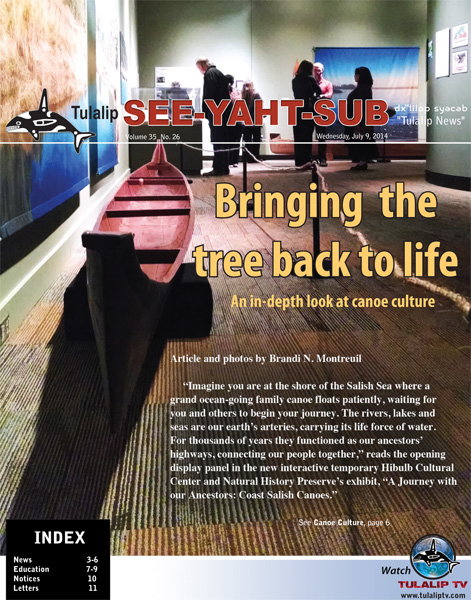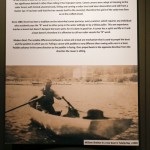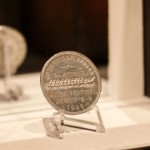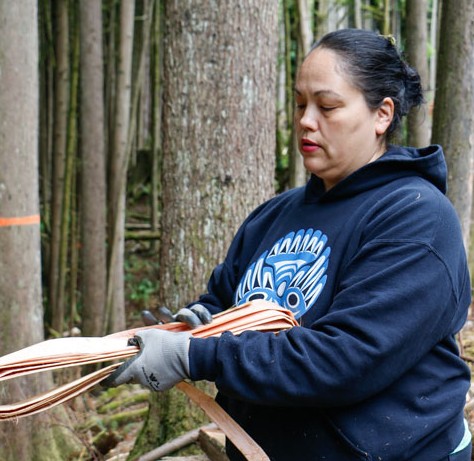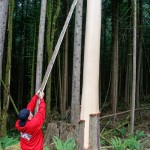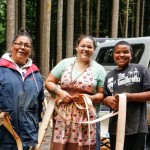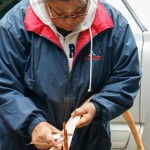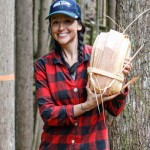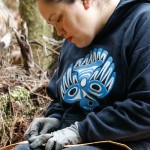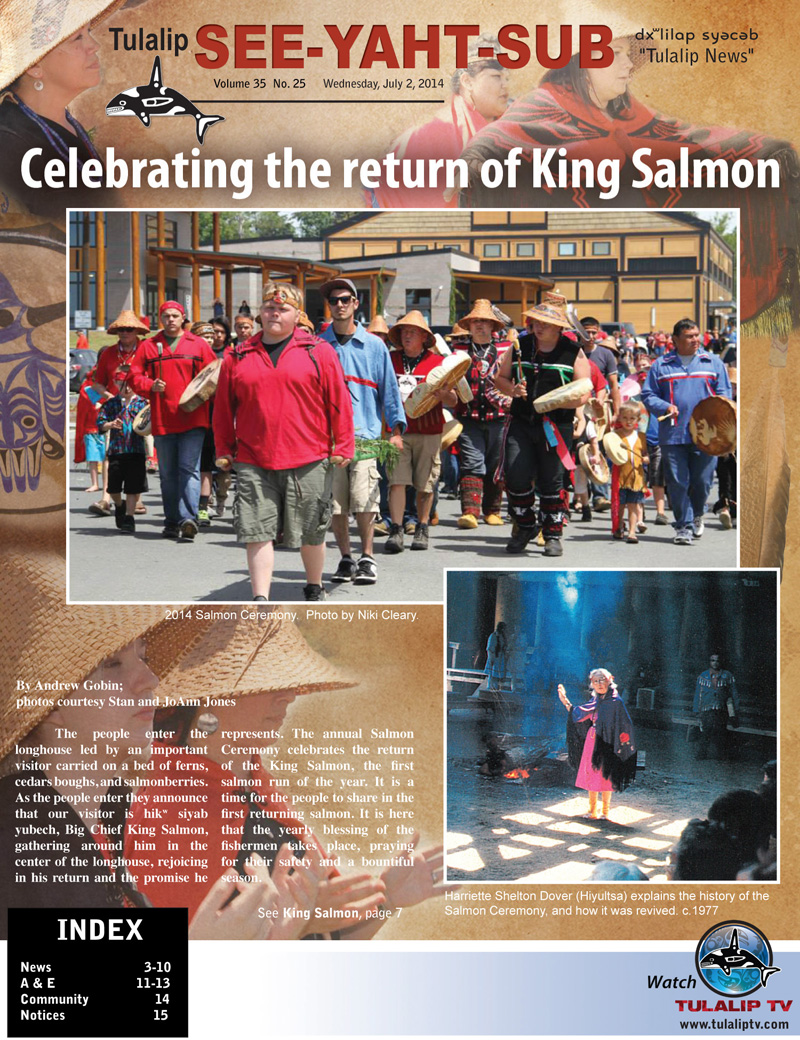Click on the link below to download the July 9, 2014 Tulalip See-Yaht-Sub Issue
Category: Tulalip News
Vice Chairman Parks delivers annual State of the Tribes address
By Andrew Gobin, Tulalip News
“In 1996, Marysville and Tulalip had just built a bridge, the 88th Street Bridge,” began Tulalip Vice Chairman Les Parks as he delivered the annual Marysville Tulalip Chamber of Commerce State of Tulalip Address. He recalled the direction Tulalip was moving in when he first served on the tribal council, and how it has changed over the last 20 years, noting the focus and success of building an economy that is mutually beneficial for both Tulalip and Marysville.
“On the east side of this bridge was a brand new corridor–and it was a big day for the Marysville Tulalip area.” Today, it is a shopping plaza that includes Haggens, Starbucks and other retail stores. “But on the west side of the freeway there was nothing but a stand of cedar trees,” he recalled. “We went to work building Quil Ceda Village. One of the greatest feelings is to do what we did here at Tulalip, for our Indian people, and the dream and the vision that we had of economic success has become a reality.”
Since the construction of the 88th Street Bridge in 1996, the Quil Ceda Village business park experienced a rapid growth in economic development, creating a successful economy which continues to grow today. In that time, Quil Ceda Village also received a charter as a federal municipality, now operating as a city, governed by the Tulalip Tribes, and yet, separate from the tribal government. Because of that structure, Quil Ceda Village has been able to contribute immensely to the greater economic development and growth of Snohomish County. Since the establishment of first federal city, Washington D.C., Quil Ceda Village is the second federally chartered city in the nation. A dream realized after more than 50 years, the village is a thriving success which has the Tulalip Tribes poised to reclaim taxes.
“The Federal Register now contains language that prohibits states and counties from assessing taxes on building improvements on and off reservation when it’s Indian owned-land and affirmed by the Great Wolf Lodge case this September in the Ninth Circuit,” continued Vice Chairman Parks. “We are currently in the process of developing an Assessor’s office so that we can begin to assess those taxes we’ve always known were ours. Tulalip itself, and I know it has been told to the Marysville Tulalip Chamber of Commerce many times, put a ton of money into the infrastructure, in the ground we’re sitting on, to the tune of about $65 million. Now I believe we are in excess of $100 million.”
“And who gets to benefit from the tax?” he asked. “Marysville does, Snohomish County does, the state does, but Tulalip gets zero,” Vice Chairman Parks explained.
There are a number of Tulalip public works projects that are underway, planned, or in the planning process that will ease some of the stressors and impacts which accompany economic expansion. Most notably are the utilities project known as the Big Water project, and revisions to the 116th Street Freeway Overpass to streamline traffic flow. Currently, the overpass is a bottleneck, with one lane in each direction, and a center turn lane for each freeway onramp.
Parks announced, “Next month we’re going to put out to bid to start construction of the bridge. In eighteen months, we’re going to see a six-lane bridge, which is what everybody’s been waiting for,” he said. “Largely, Tulalip is the lead on that project; we invest a lot of money, a lot of time, a lot of effort. We know we have been responsible for the traffic nightmare, we know Marysville has been partially responsible, but we have taken the lead. We do that because we want to be good neighbors. We want our success to be your success, and your success to be ours. Thank you Marysville, thank you everybody that’s contributed to that project,” said Vice Chairman Parks.
“In about two years we’re going to have water pumping through that new water main. 36 million gallons a day, that’s a lot of water. We may not need all that water yet but future generations will. When we decided to invest in that line through a negotiated settlement with Mayor Ray Stephanson, and the City Council of Everett, we wanted water to enhance and augment our stream flows, where our salmon are being raised, and we wanted to do that due to the loss of habitat. We want water back at Tulalip, and we’re going to use water for our people, and we’re going to us water for our salmon. For me, particularly exciting is we’re going to be able to ground inject some of that water into our streams that have low flow during the summer months, and we are going to start seeing more salmon. More salmon for our people, because that’s who we are, salmon people. That water main is two years away and stream augmentation is right behind it.”
Vice Chairman Parks emphasized the importance of Tulalip youth and the fact that they are the next generation of Tulalip leaders. Much has been set aside for them but what has been done to prepare them to manage their success? Chairman Herman Williams, who spoke at the State of the Tribes Address following Vice Chairman Parks, said he and Tulalip Board of Directors have made it clear that education is an important focus of their administration.
On March 29 of this year, the Marysville School District held a summit on education and what role it should play in the success of students. There, Troy McClelland, president and CEO of the Economic Alliance of Snohomish County said, “Snohomish County is first in the state in manufacturing. We are second in the technology field. There are many successful economies in the state, but what makes us different is, in Snohomish County, we build things. There is a place for every student to succeed, if we continue to provide the competitive economy.” Chairman Williams noted that he has spoken with Marysville Superintendent Dr. Becky Berg about this very issue, saying that what students need most for our local economy are tools. They get an education, yet lack the tools and skills to succeed.
Parks said, “For the first time in the United States, a Indian TERO program is able to certify apprenticeships in the state in which we live. Chairman Williams has had a dream that we will have a full-fledged vocational training center on the reservation. And he’s talked about this for years, he’s talked about educating our youth, and he has walked his talk over the years. He knows how important it is to educate our youth, but he also knows that when they leave high school not all of them want to go to college. Some of them want to enter into the trades, some of them want to get trained in computers; and so he’s wanted this vocational training center. The TERO commission really has taken the first step in getting that done with the apprenticeship program. I know that in the very near future, Chairman Williams is going to continue to push, and we will soon have a full-fledged vocational training center on the reservation.”
Vice Chairman Parks ended the State of the Tribes address by thanking the Tulalip and Marysville communities for their coordinated efforts to support the victims and their families of the Oso Landslide, calling it one of the most tragic events in Washington’s history. “The Oso tragedy brought back to memory a piece of Tulalip history in 1830,” he said. “We lost many of our ancestors in a slide right off the tip of Camano Island. That slide buried many, and the subsequent Tsunami drowned many more that were subsisting in villages on the beaches of Hat Island. Our Oso brothers and sisters were welcomed by our Tulalip brothers and sisters at Heaven’s gates. Today I ask that we honor and remember those lost in both tragedies,” he said.
Bringing the tree back to life
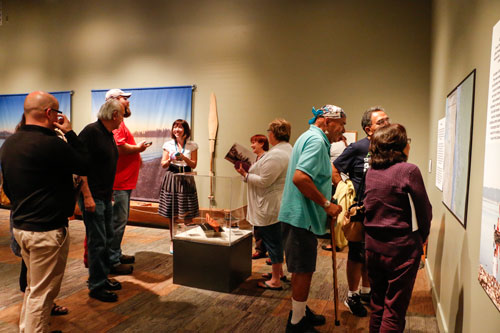
New Hibulb exhibit gives an in-depth look at Tulalip’s canoe culture
By Brandi N. Montreuil, Tulalip News
TULALIP- “Imagine you are at the shore of the Salish Sea where a grand ocean-going family canoe floats patiently, waiting for you and others to begin your journey. The rivers, lakes and seas are our earth’s arteries, carrying its life force of water. For thousands of years they functioned as our ancestors’ highways, connecting our people together,” reads the opening display panel in the new interactive temporary Hibulb Cultural Center and Natural History Preserve’s exhibit, “A Journey with our Ancestors: Coast Salish Canoes.”
The new exhibit, on display through June 2015, explores canoe culture in Tulalip and in Coast Salish tribes. A soft opening for the exhibit was held on Friday, June 27, with over 80 guests in attendance. This interactive exhibit features over 70 items that guests can explore canoe culture through, such as videos on carving canoes, maps, display panels, paddles and tools used to carve canoes with, and a large canoe that guests can sit in.

“We hope guests learn the importance of canoes and how they were tied to all aspects of our life,” explains Mary Jane Topash the center’s tour specialist, about what guests can expect from the new exhibit. “We hope to educate people on the types of canoes, anatomy, tools, what it takes to build one, and how they are still used to this day. This exhibit will encompass all aspects of the teachings, history, lifestyle, and how their importance hasn’t changed a whole lot over the years.”
Coast Salish Canoes highlights the roots of the Canoe Journey and the important role that canoes played in its revitalization during the 1989 Paddle to Seattle.
“It was a big learning process for us. It didn’t just happen in 1989,” explained Tulalip carver Joe Gobin, about the preparation involved in the Paddle to Seattle. “Frank Brown and Ray Fryberg Sr. got our [Tulalip] Board involved and the Board saw how this was something missing in our culture. They sent us to different reservations to learn, to Lummi and Makah, because none of us knew how to carve a canoe. We all talked about it and the tools we needed, and how when we were making the canoe we were bringing the tree back to life. And it did come back to life on the reservations, and it brought back so many things in our culture that were forgotten. I am glad to see this exhibit here.”

Lena Jones, the center’s curator of education, says guests will leave knowing the importance of canoes in Coast Salish culture. “Our ancestors helped keep a rich environment with superb art. We hope the exhibit will help people appreciate the social gatherings of the Coast Salish people and help our young people recognize their community’s role in revitalizing important Coast Salish traditions that can, and do, help the region.”
For more information on “Coast Salish Canoes,” please visit the Hibulb Cultural Center and Natural History Preserve’s website at www.hibulbculturalcenter.org.
Brandi N. Montreuil: 360-913-5402: bmontreuil@tulalipnews.com
The heart of a cedar
CedarPulling6-27-14A from Brandi Montreuil on Vimeo.
Sisters continue tradition of cedar harvesting
By Brandi N. Montreuil, Tulalip News

Photo/ Brandi N. Montreuil, Tulalip News
Leaning over a long strip of red cedar placed on her lap, Tulalip tribal member Cerissa “Pipud” Gobin, asked her 4-year-old daughter, Emmy “Pipud” Ramsey, if she knew what was in the center of the cedar tree.
“What is in the center of you? That is right; it is your heart. So in the center of the cedar tree is a heart,” said Gobin, as she continued her methodical rhythm of peeling inner bark from the outer bark on a strip of cedar that was recently cut from a nearby group of trees.
“When I first started pulling I had no idea what I was doing,” said Gobin. “I learned as I went along. I learned to get the little pieces of bark left on the inside off before you leave, otherwise you are going to spend a lot of time trying to get it off later,” she continued, occasionally looking up from the long strip on her lap to watch her son, Coen, pull another strip of bark off a tall red cedar.
Clustered around Gobin and her sister, Chelsea Craig, also a Tulalip tribal member, were long strips of cedar waiting to have their inner bark stripped, which will be used to make cultural items. Outer bark is left for the forest to reclaim. Both women are educators who plan to use the cedar for in-class projects next year.
Gobin, a high school art educator at Heritage High School, uses the cedar to teach students how to make traditional headbands or bracelets, some of which are later used during graduation ceremonies. Craig, a teacher at Quil Ceda & Tulalip Elementary, uses the cedar to teach youth to make baskets, hats, and pins for potlatch giveaways. Although they teach students how to weave different items, together they weave a cultural foundation for Tulalip youth.
These women are part of a large group of Tulalip tribal members participating in a cedar harvest organized by Tulalip Forestry
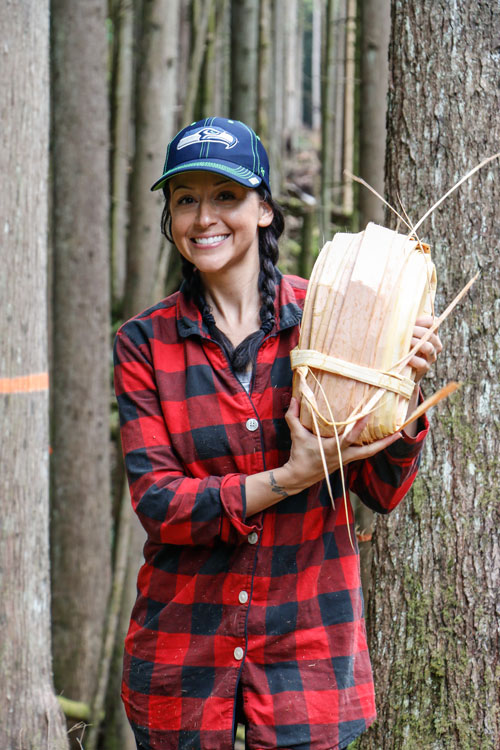
Department on June 27-28. The event, and others like it, is made possible by a growing partnership between the Tulalip Tribes and the Washington State Department of Natural Resources. The land is owned by DNR, with Sierra Pacific owning the timber. Department of Natural Resources notifies Tulalip Forestry when an area is scheduled to be cleared. This season, 83 acres were available for harvesting cedar.
“Tulalip Forestry worked in conjunction with both agencies’ representatives to coordinate the event and establish ground rules regarding allowable and non-allowable trees to be pulled,” explained Ross Fenton with the Tribe’s forestry department. “The relations Tulalip Forestry has established over the years for cultural cedar bark gathering has gone exceptionally well. Some tribal members base their sole incomes on products they make from cedar bark, so it’s very important we continue to maintain these positive relations.”
“Traditionally we would come out to harvest when the sap would run. That makes it easy to pull it off the tree. This stuff peels so nicely, I am loving it,” said Craig, pausing for a moment to survey the large expanse of trees swaying in the afternoon wind. “It is amazing to sit here and think about how our people used to do this. How they would all come together with their families and gather cedar. Of course they didn’t use the same tools we are using today, but they came out and gathered and made things, some of which we still have today.”
Many Tulalip youth participated in the two-day cedar-harvesting event, gathering strips for elders and learning techniques of separating the smooth inner bark from the rough outer bark. For many, this was their first trip gathering cedar.
“Do you know how the cedar is related to us?” asked Craig to her nephew and nieces, who were struggling to bring the long cedar strips up the steep incline. “She is our grandmother and she is giving us this gift of cedar and we need to thank her.”
“I love being out here,” said Gobin, as she tightly wound her cedar into a bundle tying it off with a scrap of thin cedar. “It is really addicting to be out here stripping the cedar, it is one of my favorite things to do.”
“Yes, grandpa would be proud of us,” remarked Craig.
For more information regarding future cedar harvesting events, please contact Tulalip Forestry at 360-716-4000.
Brandi N. Montreuil: 360-913-5402; bmontreuil@tulalipnews.com
Unintentional state waiver lets FERC pre-empt state Coastal Zone rules
WASHINGTON, D.C.
The Federal Energy Regulatory Commission has issued a declaratory order that FERC hydropower licensing under the Federal Power Act pre-empts state regulation under the Coastal Zone Management Act in an instance in which the state of Washington unintentionally waived its CZMA permit authority.
The June 19 ruling blocks a state-imposed stay of construction and allows work to begin on the 600-kW Admiralty Inlet Pilot tidal project (No. 12690) to be installed in Washington’s Puget Sound. FERC issued a hydrokinetic pilot project license to Admiralty Inlet on March 20. FERC and the state of Washington agreed in 2009 to coordinate procedures and schedules for reviewing hydrokinetic energy projects in state waters of Washington.
As a pre-requisite for FERC licensing, a state agency has six months from application in which to issue a shoreline management permit under the Coastal Zone Management Act.
While license applicant Snohomish County Public Utility District No. 1 filed a CZMA application with the Washington Department of Ecology in March 2012, Snohomish and Ecology advised FERC by joint letter in September 2012 that they had agreed to extend the state’s review period. However, the National Oceanic and Atmospheric Administration, which administers the CZMA, found extension of the review period did not comply with federal regulations and, as a result, Ecology waived its CZMA authority.
In May 2014, Ecology issued a shoreline permit for Admiralty Inlet incorporating conditions set by Island County, Wash., under state CZMA regulations including a requirement that project construction be delayed until appeals of the permit are concluded.
“The district argues that this stay would prevent it from implementing the terms of its license, which authorizes immediate construction of the project after the commission grants the necessary pre-construction approvals,” FERC said. “Because Article 410 of the license and biological opinion require that construction can only occur during a work window of July 16 to October 14, the district argues that it could miss this work window and construction could be delayed by one to two years.”
FERC agreed to Snohomish PUD’s request for a declaratory order upholding Federal Power Act pre-emption of state regulation.
“Because Ecology waived its consistency certification under the CZMA, a Shoreline Permit under Washington’s Shoreline Act is no longer required as a matter of federal law,” the commission said. “Therefore, we grant the district’s petition and declare that the FPA pre-empts any supplementary or inconsistent state or local requirements under Washington’s Shoreline Act. The district need not comply with the state-imposed stay provision of condition 23 of its Shoreline Permit. To hold otherwise would be inconsistent with the FPA, because it would allow the state permit to stay a commission hydroelectric license.”
FERC noted that Snohomish has informed Ecology and Island County that it intends to comply voluntarily with all provisions of the shoreline permit except the stay of construction.
“As a general matter, the commission encourages licensees to comply with state and local requirements to the extent that they do not conflict with the commission’s requirements or frustrate the purposes of the FPA,” FERC said. “We recognize, however, that under the Supremacy Clause of the Constitution, federal law pre-empts state and local laws when Congress occupies the field by enacting comprehensive legislation that leaves no room for supplemental state or local regulation.”
“This is significant for licensees who attempt to implement license obligations but are barred or delayed by state and local regulatory authorities with standards that conflict with the license,” said Mike Swiger of law firm Van Ness Feldman, which represented Snohomish.
Subsea cable operator challenge pending
FERC said it would address in a subsequent order a challenge by Pacific Crossing, owner of PC-1, a subsea telecommunications cable linking the United States and Japan, to the licensing of Admiralty Inlet.
Pacific Crossing unit PC Landing Corp. previously requested rehearing of the licensing order, saying the project would pose a risk to its nearby fiber-optic cable in Washington’s Puget Sound.
FERC also denied a requested stay but said it would address a rehearing request by the Tulalip Tribes of Washington who contend the project would affect access to its fishing grounds.
Everett Community College Cosmetology Program at Tulalip
Hibulb Cultural Center Film Series, Sunday June 29
Video: U.S. Army Corps of Engineers and Tulalip leadership visit Qwuloolt
By: Tulalip TV
On June 25th, U.S. Army Corps of Engineers and Tulalip leadership visit Qwuloolt
Watch Qwuloolt from Tulalip News on Vimeo.
Video: Tulalip Salmon Ceremony 2014
Watch video from the 2014 Tulalip Tribes Salmon Ceremony.
Produced by the Tulalip Tribes Communications Dept.

